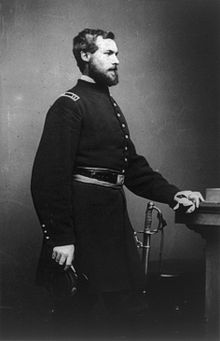Louis Philippe Albert d'Orléans, comte de Paris
Louis Philippe Albert d'Orléans, comte de Paris (born August 24, 1838 in Paris , † September 8, 1894 in Stowe , Buckinghamshire ) was the eldest son of Ferdinand Philippe d'Orléans, duc de Chartres , and grandson of the last French king Ludwig Philipp .
Life
After the death of his father in 1842, Louis Philippe advanced to the position of the designated successor (Prince royal) of his grandfather, King Ludwig Philipp , for the office of King of the French. After the February Revolution of 1848 , however, he was forced to go into exile in Britain with his family. Since the death of his grandfather in 1850, he was recognized by the supporters of the House of Orléans ( Orléanists ) as a legitimate pretender to the French throne. During the Civil War , he served as an officer in the Union Army with his brother Robert d'Orléans and other family members . As a member of the staff of the Potomac Army under General George B. McClellan , he distinguished himself in the 1862 Peninsula Campaign . He wrote a four-volume historical work about the civil war.
After the fall of the Second French Empire in 1870, the two monarchist currents of the Orléanists and Legitimists attempted mutual reconciliation with the aim of restoring the monarchy. As their king, the Bourbon Comte de Chambord was to be recognized as "Henry V" by the Orléans , who in turn was to recognize the constitutional " July Monarchy " as the state constitution. This "merger" failed, however, because of the ultra-loyal sentiments of the Comte de Chambord, who in his manifesto published on July 5, 1871 refused to accept the revolutionary tricolor and the royal coat of arms of the three golden lilies on a blue shield as external symbols of the French state accept. For him, only the white lily banner of the absolutist Ancien Régime was acceptable, while Louis Philippe supported the compromise. Behind this flag dispute, the two opposing views of divine right on the one hand and the principle of national sovereignty established by the revolution on the other hand manifested themselves .
In 1873 Louis Philippe made another attempt to find a compromise with the Comte de Chambord in his exile in Frohsdorf , and recognized his right to the throne. However, the agreement only remained superficial, as the two camps' different views remained. After the Comte de Chambord died childless in 1883 and the royal line of the Bourbons was thus extinguished, Louis Philippe formulated as "Philip VII." The claim of the House of Orléans to the legitimate representation of the " House of France " and thus his sole right of succession to the throne. Ultra-loyal supporters of the Legitimists, however, rejected this and proclaimed a representative of the Spanish Bourbons ( House Bourbon-Anjou ), their own pretender, which continued the split in the monarchist movement.
In the meantime the third republic was consolidated and in 1876 the monarchists lost the majority in the Chamber of Deputies to the republicans. On June 22, 1886, the law to exile the House of Orléans from France was passed, after which Louis Philippe moved back to England. There he was buried after his death in the Saint-Charles Borromée Chapel of Weybridge . The House of Orléans was only allowed to return to France in 1950 after the exile law was repealed, whereupon his body was transferred to the Chapelle royale Saint-Louis in Dreux , the traditional burial place of the family, with those of other exiled Orléans in 1958 .
family
On May 30, 1864, Louis Philippe married his cousin Maria Isabella d'Orléans-Montpensier (1848–1919), daughter of Antoine d'Orléans , Duke of Montpensier, with whom he had eight children:
- Marie Amélie Louise Hélène (1865–1951); ∞ King Charles I of Portugal
- Louis Philippe Robert d'Orléans (1869–1926), Duke of Orléans
- Hélène Louise Françoise Henriette (1871–1951); ∞ Emanuel Philibert of Savoy-Aosta (1869–1931), son of King Amadeus I of Spain
- Charles (* / † 1875)
- Isabelle Marie Laure Mercédès Ferdinande (1878–1961); ∞ Jean d'Orléans , Duke of Guise
- Jacques Marie Antoine Clément (1880–1881)
- Louise Françoise Marie Laure (1882–1958) ∞ Prince Carlos Maria de Bourbon
- Ferdinand François Philippe Marie Laurent (1884–1924), Duke of Montpensier
plant
- Louis Philippe Albert d'Orléans, Comte de Paris: History of the Civil War in America (Philadelphia, Porter and Coates, 1875–1888), in 4 volumes
literature
- Klaus Malettke : The Bourbons. W. Kohlhammer Verlag, 2009, Volume 3, pp. 210-212.
- Thibault Gandouly: Philippe d'Orléans, comte de Paris (1838-1894) . Via Romana Editions, Versailles 2020, ISBN 978-2-37271-149-4 .
Web links
| predecessor | Office | successor |
|---|---|---|
| Louis Philippe d'Orléans, King of the French |
 Head of the House of Orléans orléanist pretender to the throne of France 1850–1894 |
Louis Philippe Robert d'Orléans |
| personal data | |
|---|---|
| SURNAME | Paris, Louis Philippe Albert d'Orléans, comte de |
| BRIEF DESCRIPTION | French pretender to the throne |
| DATE OF BIRTH | August 24, 1838 |
| PLACE OF BIRTH | Paris |
| DATE OF DEATH | September 8, 1894 |
| Place of death | Stowe , Buckinghamshire |
